
* For over 40 years, one of the mainstays of the Aeronavale, the French Navy's air arm, was the Dassault "Etendard" and "Super Etendard" carrier-based single-seat strike fighters. This document provides a history and description of the Etendard and Super Etendard.
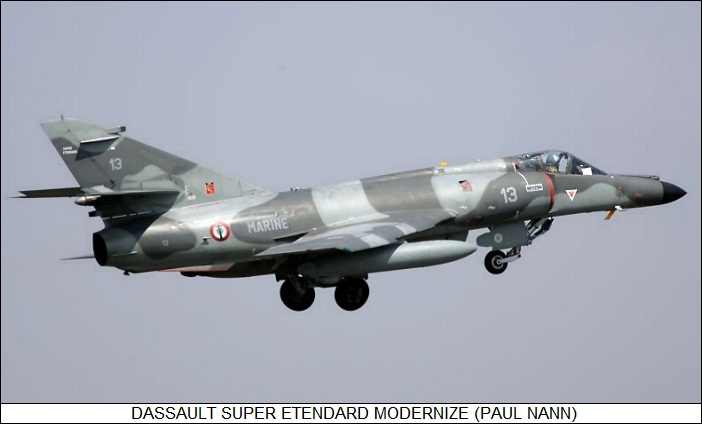
* In 1953, NATO issued a requirement designated "NATO Basic Military Requirement 1 (NBMR-1)" for a "light weight tactical strike fighter (LWTSF)" that would be fitted with four 12.7-millimeter (0.50-caliber) Browning machine guns, would be easy to maintain in austere conditions, and could operate from unimproved front-line airfields. The Armee de l'Air (AA), the French air force, had a requirement along much the same lines, but wanted a twin-engine configuration and armament of twin DEFA 30-millimeter revolver-type cannon.
Officials of the French Dassault aircraft firm decided to design an aircraft for each requirement, with the two types sharing common features and technology. The single-engine machine for the NATO requirement was originally designated the "Mystere XXVI", though it soon became the "Etendard VI", where "Etendard" means "Standard", in the sense of a battle flag. The twin-engine machine for the AA requirement was originally designated the "Mystere XXII", though it was then renamed the "Etendard II".
* Three prototypes for the single-engine Etendard VI were ordered in July 1955, with the first performing its initial flight on 15 March 1957. It was a neat little aircraft, with a fuselage like that of Dassault's new Mirage I tailless delta-winged fighter, the direct ancestor of the popular Mirage III -- but with conventional dogtoothed swept wings like those of the Dassault Super Mystere fighter and a swept tail assembly. The Etendard VI had tricycle landing gear, all assemblies with single wheels, the nose wheel retracting backward and the main gear hinging from the wings towards the fuselage.
The Etendard VI had a length of 12.4 meters (40 feet 8 inches), a span of 8.16 meters (26 feet 9 inches), and an empty weight of 3,720 kilograms (8,200 pounds). Maximum speed was high subsonic. Armament was, as per NBMR-1 specification, four 12.7-millimeter Browning machine guns, with a modest external warload of 540 kilograms (1,190 pounds) carried on underwing pylons.
The Etendard VI was initially powered by Bristol Siddeley Orpheus BOr.1 turbojet with 16.7 kN (1,700 kgp / 3,750 lbf) thrust, but the aircraft proved underpowered and so it was refitted with an uprated BOr.3 engine with 21.6 kN (2,200 kgp / 4,850 lbf) thrust. The second Etendard VI prototype, which featured the BOr.3 engine from the outset, performed its initial flight on 14 September 1957. It featured larger intakes to provide more airflow for the BOr.3 engine, and had internal armament of twin 30-millimeter DEFA cannon.
Both Etendard VI prototypes went through the trials for the NBMR-1 specification, but the competition was won by the Italian Fiat G.91 light strike fighter. The third Etendard VI prototype was not built. It was to have an "area-ruled" fuselage -- in which changes to the aircraft cross-section were minimized to reduce transonic drag, resulting in a "wasp-waisted" appearance -- and a further uprated BOr.12 engine, with provision for afterburning.
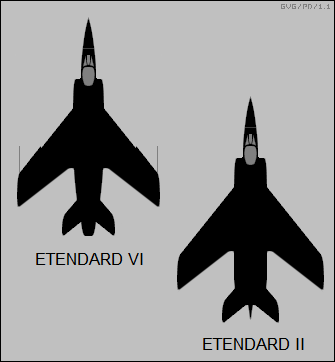
* Three prototypes of the Etendard II were ordered as well, with the first performing its initial flight on 23 July 1956, well before the first flight of the Etendard VI, with Paul Bourdier at the controls. The Etendard II looked much like the Etendard VI, except for a wider fuselage to accommodate twin Turbomeca Gabizo turbojets, with 9.2 kN (940 kgp / 2,070 lbf) thrust each, and with no wing dogtooth. The Etendard II was slightly larger than the Etendard VI, with a length of 12.89 meters (42 feet 4 inches), a span of 8.74 meters (28 feet 8 inches), and an empty weight of 4,120 kilograms (9,280 pounds).
Armament was to be twin 30-millimeter DEFA cannon in a pack that could be swapped out with a pack for 32 Matra 68-millimeter unguided rockets. Not surprisingly, given greater weight than the Etendard VI but substantially less engine thrust, the Etendard II was badly underpowered. This deficiency was in principle to be addressed with an improved Gabizo with afterburning, but the engine program foundered. Other engine fits were considered, but the Etendard II was judged unpromising and canceled in November 1956. The second and third prototypes were never built.
BACK_TO_TOP* Although the Etendard VI and II were dead ends, Dassault was energetic in pursuing the general design concept, using company funds to develop something along the lines of a scaled-up Etendard VI and designated the "Etendard IV". Initial flight of the single prototype was on 24 July 1956, with Georges Brian at the controls.
The Etendard IV had very much the same general configuration as the Etendard VI but was well bigger, with an empty weight about a third greater. The Etendard IV was powered by a single SNECMA Atar 101E-4 turbojet with 33.4 kN (3,400 kgp / 7,495 lbf) thrust. It had internal armament of twin 30-millimeter DEFA cannon.
Dassault promoted a set of different variants of the Etendard IV, including a tandem-seat trainer, a tactical reconnaissance machine, and a multirole carrier-based fighter. The AA wasn't interested, but the Aeronavale, the French naval air arm, was intrigued and ordered a semi-navalized prototype of the Etendard IV in December 1956, followed by an order for a batch of five fully-navalized pre-production machines as the "Etendard IVM" -- where "M" stood for "Marine" -- in May 1957.
The two Etendard VI prototypes were put to work evaluating technology for the Etendard IVM. The prototype Etendard IVM performed its initial flight on 21 May 1958, with the first pre-production aircraft following on 21 December 1958. Both machines were powered by the SNECMA Atar 08B turbojet, providing 43.2 kN (4,400 kgp / 9,700 lbf) thrust; the Atar was not fitted with an afterburner, though it did have a two-piece "eyelid"-type variable exhaust. The second pre-production machine was fitted with Rolls-Royce Avon 51 turbojet with 49.8 kN (5,080 kgp / 11,200 lbf) thrust and was configured for "boundary layer control" or "flap blowing", with engine air bleed driven over the top of the flaps to keep them effective at low airspeeds. This machine was designated the "Etendard IVB", but the configuration was not adopted for production.
The Etendard IVM went into formal service with the Aeronavale in 1961, with 69 machines being delivered into 1965, the aircraft serving on the carriers CLEMENCEAU and FOCH. A sixth pre-production machine was ordered in 1959, this aircraft being configured as a photo-reconnaissance platform. It performed its first flight on 18 November 1960, with Jean-Marie Saget at the controls, and was put into service as the "Etendard IVP". 21 Etendard IVPs were built in parallel with Etendard IVM production.
* As mentioned, the Etendard IVM looked like a scaled-up Etendard VI, with an area-ruled fuselage and all-swept flight surfaces, the low-mounted wing featuring a leading-edge dogtooth and the tailplane mid-mounted on the tailfin; side-mounted engine intakes; and tricycle landing gear like that of the Etendard VI. The intakes were of fixed dee type with short "splitter plates" forward to prevent ingestion of stagnant "boundary layer" air found next to the fuselage; there were spring-loaded intake relief doors back on the engine nacelles to provide additional airflow for take-offs and the like.
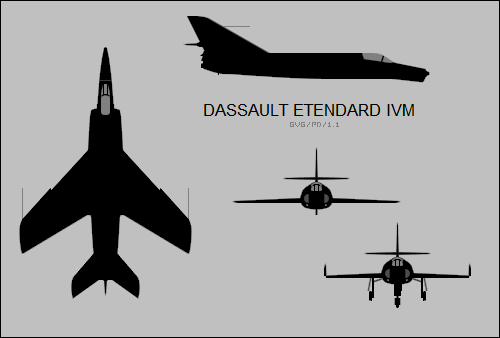
The powerplant was the Atar 08C, generally like the Atar 08B but with a self-starter system instead of an externally driven compressed-air starter system. Internal armament was twin DEFA 30-millimeter revolver cannon, with the cannon mounted underneath the engine intakes and provided with 125 rounds of ammunition each.
___________________________________________________________________
DASSAULT ETENDARD IVM:
___________________________________________________________________
wingspan:
9.6 meters (31 feet 6 inches)
wing area:
28.4 sq_meters (306 sq_feet)
length:
14.4 meters (47 feet 3 inches)
height:
3.9 meters (13 feet)
empty weight:
5,900 kilograms (13,000 pounds)
normal loaded weight:
8,165 kilograms (18,000 pounds)
MTO weight:
10,200 kilograms (22,485 pounds)
max speed at altitude:
1,380 KPH (858 MPH / 745 KT)
service ceiling:
15,500 meters (50,850 feet)
tactical range:
1,300 kilometers (800 MI / 695 NMI)
ferry range:
3,100 kilometers (1,935 MI / 1,680 NMI)
___________________________________________________________________
Navalizations included a catapult cable attachment hook under the forward corner of each wing, long-stroke landing gear with an extensible nosewheel to raise the angle of attack for launchings, a yoke-style arresting hook, and folding wingtips. There were leading-edge slats on the wings out to the wingfold, with double slotted flaps in the rear along with ailerons; the ailerons were also inboard of the wingfold. There were perforated spoilers on top of the wing outboard of the wingfold. The tailplane was "all moving", but had elevators as well.
The wing had twin spars and a leading-edge sweep of 45 degrees. The ailerons, tailplane, and rudder were hydraulically actuated. There were twin perforated, hydraulically operated airbrakes on the belly near the leading edge of the wingroots, and there was a brake parachute fairing on the back of the tailfin where it intersected the tailplane, the parachute of course being used only on ground landings.
The Etendard IVM featured fuel tanks in the fuselage and wings, with a total internal fuel load of 3,300 liters (871 US gallons). There were two stores pylons under each wing and a pylon under the forward fuselage, for a total of five pylons. The inner wing pylons were "wet" for carriage of 625-liter (165 US gallon) external fuel tanks. Given that the Etendard IV's range was unspectacular, twin fuel tanks were normal kit. Each outer pylon could carry a munition, for a total of two, with typical stores including:
Total external stores load was 1,360 kilograms (3,000 pounds).
The Etendard IVM featured a retractable inflight refueling probe on the top of the nose. Some pictures of Etendard IVMs do not show the refueling probe fixture; these may have been developmental aircraft. The pilot sat under a rear-hinged clamshell canopy on a British Martin-Baker Mark 4 lightweight ejection seat, license-built by Hispano in France. The cockpit was pressurized, air-conditioned, and protected by armor. A simple Dassault Aida 7 navigation radar was carried in the nose, and the aircraft was also fitted with a Swedish SAAB BT9F bombing computer.
* The Etendard IVP was similar to the Etendard IVM, but the cannon were deleted, with the payload consisting of three film cameras in a modified nose -- one camera staring forward and one staring to each side -- plus a removeable belly camera pack with two cameras. All the cameras were built by the French OMERA organization. The Etendard IVP carried flares or flash bomblets for night photography.
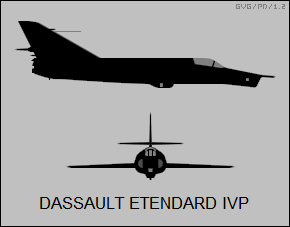
The belly camera pack could be removed and a US Douglas-built tanker pod fitted in its place on a centerline pylon, with the tanker pod pump driven by a prominent spinner on the pod's nose. Later production Etendard IVMs could also carry the tanker pod. In principle, the centerline pylon could also carry a bulbous 600-liter (158 US gallon) external tank that looked much like the tanker pod without the spinner -- but few pictures seem to show the centerline pylon being used for anything but the tanker pod.
The Etendard IVP featured a fixed inflight refueling probe on the nose. As with the Etendard IVM, some pictures do not show the probe; and this may have been the single developmental aircraft.
* Attrition of the modest number of Etendard IVPs through the 1960s and 1970s meant that the Aeronavale ended up running low on reconnaissance assets, and so in 1977 the decision was made to convert four Etendard IVMs into reconnaissance machines. The conversions were delivered in 1978 and 1979. The upgraded machines were very difficult to distinguish from production Etendard IVPs, though they featured very slight detail differences.
A modernization program was implemented from 1989 into 1994 that fitted the Etendard IVP with an updated inertial navigation system (INS), a cockpit instrumentation update, and a DRAX 16 radar warning receiver (RWR). The RWR featured spikelike antenna fairings on the upper front and lower rear of the tailfin, with a flush antenna on each side of the tailfin. The aircraft was also wired for the Matra Magic II AAM. The updated machines were designated "Etendard IVPM", with the "M" standing for "Modernization". (Confusingly, some sources claim the IVPM label only applied to the four Etendard IVMs updated to Etendard IVP spec.) Etendard IVPMs often carried pylon-mounted countermeasures gear, such as an LC III or Phimat chaff dispenser, and a Barracuda jammer.
* In service, the Etendard IVM/IVP was usually painted dark gray-blue on top and white on the bottom. The Etendard IVM saw little or no combat action, the Aeronavale not being involved in much active fighting during the aircraft's lifetime. The type was phased out in favor of its improved successor, the Super Etendard (discussed later) beginning in the late 1970s, with some lingering in service into 1991 as land-based operational trainers.
The Etendard IVP/PM had a much livelier combat history, flying reconnaissance missions over Middle Eastern combat zones from the 1970s and over the former Yugoslavia in the 1990s. In later service, the Etendard IVP/PM was painted in a two-tone disruptive pattern of medium and light gray-blue. The Etendard IVP/PM was finally retired from operational service in July 2000 after decades of useful service, to be replaced by reconnaissance-configured Super Etendards.
BACK_TO_TOP* The Etendard IVM was beginning to appear behind the times in the late 1960s, and so the Aeronavale started to cast around for a replacement. There were a number of good candidates, a prominent one being the US Vought A-7 strike fighter; the Aeronavale was an enthusiastic operator of the A-7's cousin, the Vought F-8 Crusader, and the admirals had no strong reason to turn up their noses at the A-7 simply because it was made in the USA. They also had a partly French-built candidate, a navalized version of the Anglo-French SEPECAT Jaguar, the "Jaguar M".
However, although Vought and SEPECAT had excellent products, and some sources claim that the Aeronavale was leaning towards the A-7, it seems that Dassault had superb salesmen who gave a pitch that was unarguably hard to turn down on the face of it: why not just update the Etendard IVM? The improved version would be "90% compatible", making it a cheap solution, and it would be an all-French product as well. What wasn't to like? The "Super Etendard", as it was known, won the competition in January 1973.
* Three Etendard IVMs were used as developmental aircraft in the program, with the first true prototype performing its initial flight on 3 October 1975. The first production machine performed its initial flight on 24 November 1977, with the first deliveries of what would turn out to be a total of 71 Super Etendards to the Aeronavale the next year.
One of the major changes in the Super Etendard, or "SuE" as it was called, was fit of the improved SNECMA Atar 8K50 non-afterburning turbojet, with a maximum thrust of 49.0 kN (5,000 kgp / 11,025 lbf). It was also supposed to have better specific fuel consumption, but it seems it was little or no improvement in that regard. Internal fuel capacity was increased to 3,270 liters (845 US gallons) in some compensation. The Atar 8K50 was derived from the 9K50 turbojet used on the Dassault Mirage F1, with corrosion protection added and the afterburner removed. It had a fixed exhaust nozzle, unlike the "eyelid" nozzle of the Atar 08B fitted to the Etendard IVM. Bigger engine intakes were fitted to the SuE to provide adequate airflow to the uprated engine.
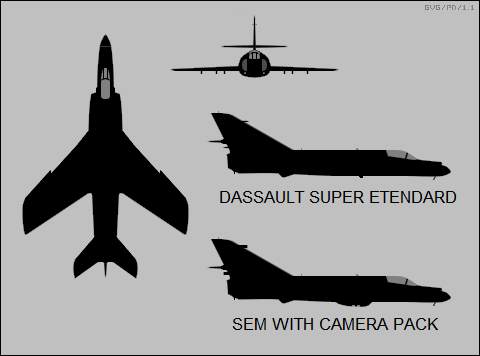
Another major change was fit of an updated avionics suite, including:
The third major change was fit of a new wing to compensate for increased take-off weight. The wing looked much like the old, but featured leading-edge wingroot extensions, with a slightly enhanced sweep; leading-edge slats running all the way to the wingtip, instead of out to the wingtip fold as with the Etendard IV; and double slotted flaps with greater droop.
___________________________________________________________________
DASSAULT SUPER ETENDARD:
___________________________________________________________________
wingspan:
9.6 meters (31 feet 6 inches)
wing area:
28.4 sq_meters (306 sq_feet)
length:
14.31 meters (46 feet 11 inches)
height:
3.9 meters (13 feet)
empty weight:
6,500 kilograms (14,330 pounds)
MTO weight:
12,000 kilograms (26,455 pounds)
max speed at altitude:
1,380 KPH (858 MPH / 745 KT)
service ceiling:
15,500 meters (50,850 feet)
combat radius:
850 kilometers (530 MI / 460 NMI)
___________________________________________________________________
* Outside of these changes, the Super Etendard was very much like the Etendard IVM, with four underwing pylons and a centerline pylon; twin DEFA cannon; a retractable inflight refueling probe on top of the nose; and so on. In fact, if it weren't for the different nose, it would be difficult to tell the Etendard IVM and Super Etendard apart. However, the notion that the Super Etendard was going to be "90% compatible" with the Etendard IVM was replaced by the reality that the two were closer to "90% different", and the supposed cost benefits didn't materialize. The Aeronavale had wanted 100 Super Etendards, but cost escalation reduced the quantity to the 71 mentioned above. For the same money, the Aeronavale could have obtained more aircraft with greater warload capability and radius of action.
That said, the Super Etendard was a perfectly effective machine, with excellent handling -- one Aeronavale pilot described it as "a no-brainer to fly" -- and effectively state-of-the-art in terms of its technical sophistication, in particular providing a platform for carriage and launch of the Aerospatiale AM39 Exocet solid-fuel antiship missile, with the Agave radar providing targeting. The usual flight configuration for the antiship attack mission was an Exocet on the inner pylon of one wing and an external tank under the inner pylon of the other, with AAMs or defensive aids optionally carried on the outer pylons. The empty external tank was dropped before missile launch to maintain trim.
In the early 1980s, most of the Super Etendard fleet was updated to support the nuclear strike mission, with the flight configuration much like that used for the Exocet -- a nuclear store on one inner pylon, an external tank on the other, and optionally AAMs (usually the Matra Magic) or defensive aids on the outer pylons. Nuclear stores included the AN52 tactical nuclear free-fall bomb, with a yield of about 15 kilotons; or the ramjet-powered "Air-Sol Moyenne Portee (ASMP)" missile, with a yield of over 100 kilotons, a speed in the range of Mach 2 to Mach 3 depending on altitude, and a standoff range of about 100 kilometers (60 miles). Carriage of the Exocet or ASMP required removal of the 30-millimeter cannon to make room for "black boxes".
Of course, conventional stores like those carried by the Etendard IVM could also be employed, such as dumb bombs and unguided rocket pods, with a munition on each outer pylon and an external tank on each inner pylon.
A bigger external tank, with a capacity of 1,100 liters (290 US gallons), was introduced for the Super Etendard, taking advantage of the SuE's greater carriage capacity. However, a pair of the big tanks was too heavy if a full combat load was also being carried, and in that case the old 625-liter tanks were fitted instead. Since an Exocet strike configuration included only one tank, the 1,100-liter tank was usually carried for that mission. The Super Etendard could also carry the old 600-liter centerline tank, though again it is unusual to find pictures with it fitted. Of course, the old Douglas tanker pod could be carried as well.
Maximum external load with full internal fuel was 2,100 kilograms (4,360 pounds). Initially colors were the same as for the earlier Aeronavale Etendards -- dark gray-blue on top, white on bottom -- but were later changed to the overall two-tone gray-blue disruptive pattern also given to the Etendard IVP/PM.
BACK_TO_TOP* Although the Etendard IVM never got involved in serious fighting, the Super Etendard quickly found itself in combat. On 22 September 1983, Super Etendards operating in support of French peacekeeping forces in Lebanon performed airstrikes against gun emplacements of the Lebanese Druze militia.
More was to come. Argentina was the only foreign country to buy the Super Etendard, ordering 14 machines in 1981, with five delivered, along with five Exocet missiles, by the outbreak of the Falklands War in 1982; the French then suspended deliveries. On 4 May 1982, Argentine Super Etendards launched two Exocets, damaging the British destroyer HMS SHEFFIELD badly enough that it had to be scuttled, and then fired two more Exocets against the container ship ATLANTIC CONVEYOR on 25 May 1982, with the same result. These successes were among the few enjoyed by the Argentines during the conflict.
The last Argentine Exocet was expended without result on 30 May 1982. Deliveries of Super Etendards from France resumed after the end of the war. Argentine Super Etendards carried the locally-built Pescador missile, a radio-guided weapon somewhat along the lines of the old US Bullpup-A. Argentine SuEs were finally retired from 2025.
Iraq also operated Super Etendards during the Iran-Iraq War in the 1980s, though the Iraqis never bought them. Saddam Hussein had purchased Exocets from France but didn't have an adequate launch platform for them, and so the French agreeably loaned him five Aeronavale Super Etendards in secret in 1983 as a stopgap until the Iraqis obtained Exocet-configured Dassault Mirage F1s in 1985. The Iraqi Super Etendards went into combat in 1984 and performed dozens of attacks on tankers in the Persian Gulf during their stint in the conflict. One SuE was lost in the fighting.
* In the late 1980s, a series of enhancements were implemented for the Super Etendard, resulting in the "Super Etendard Modernise (SEM)". The initial SEM configuration, known as "Standard 2" -- the original Super Etendard of course being "Standard 1" -- involved:
First flight of a Standard 2 SEM was in October 1990, with initial service delivery in June 1993.
The Standard 2 was quickly followed by the "Standard 3" SEM, which introduced carriage of the ATLIS laser targeting pod on the centerline station. Once again, the cannon had to be removed to accommodate black boxes when ATLIS was carried. ATLIS was a daylight targeting pod with a TV camera featuring 2.5/5/10/20 magnification zoom boresighted to a laser, and the ability to automatically track a target after being locked -- a useful feature when employed by a single-seat aircraft like the Super Etendard.
When carrying an ATLIS pod, a SEM could perform precision targeting for an AS-30L missile -- a laser-guided derivative of the old radio-guided AS-30 -- or laser-guided bombs (LGB). For some obscure reason, the Standard 3 SEM could not designate its own LGBs; it could only be used for "buddy lasing" of such weapons, with a SEM targeting LGBs for another strike aircraft.
The "Standard 4" SEM was a big step forward, featuring:
A total of 47 SEMs were up to Standard 4 by the end of 2002, with the "Standard 5" introduced the next year. Standard 5 was intended to provide a "night attack" capability, built around the new Damocles targeting pod. The Damocles not only used an infrared imager, permitting night operations, but also had higher image resolution, permitting greater standoff range.
The Standard 5 SEM cockpit was modified with lighting compatible with night vision goggles (NVGs). Aeronavale pilots trained for NVG flight operations were called "Hiboux (Owls)", and wore owl patches. Another major innovation with the Standard 5 SEM was the PCN 90 flight computer and the associated UNI 40 INS with a Global Position System (GPS) satellite receiver subsystem. The PCN 90/UNI 140 system allowed up to 63 navigation waypoints to be preprogrammed before a mission.
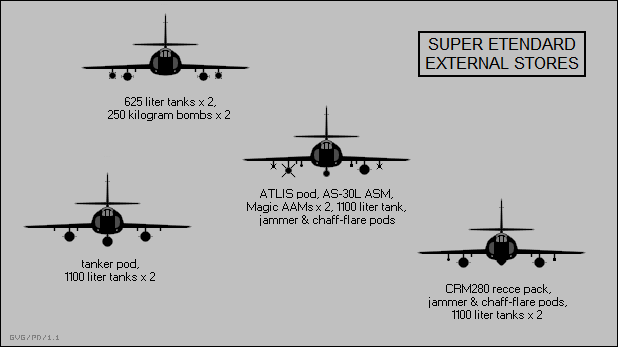
Weapons loads included the Exocet, the ASMP, the AS-30L, LGBs, and the Matra Magic II AAM. A dual-stores rack was added to permit the carriage of two 250-kilogram (550-pound) bombs under each wing. The classic SNEB 68-millimeter unguided rocket pod was retired from service with the SEM, since the pilot had to fly straight in towards the target and the rocket's short range brought the aircraft too close to adversary defenses. It should be noted that when operating from a carrier, weapons like the Exocet and AS-30L were too heavy for safe landings; they had to be discarded if they weren't otherwise expended.
34 SEMs were brought up to level 5. From 2009, Argentine Super Etendards were run through an update program, presumably to bring them up to something like Standard 5 SEM.
* The Aeronavale's SEMs saw combat action during the Balkan Wars in the late 1990s and in the invasion of Afghanistan in 2002, to continue in operations there to 2010 in support of the Afghan government in its struggles against Taliban insurgents. When operating out of "hot and high" Afghan airfields, the SEMs could only carry a single LGB. They were given updates for the operation, including updated radios and datalinks -- presumably for interoperability with other NATO participants -- as well as a multi-function electronic "kneeboard".
The SEM participated in the NATO air offensive in Libya in 2011, as well as in the intervention in Syria and Iraq against Islamic State insurgents in 2015. The SEM was finally phased out of French operational service in the summer of 2016; it has been replaced by the far more capable Dassault Rafale M multi-role shipboard fighter. Five of the SEMs were sold to Argentina in 2017, with deliveries in 2020. They never became operational, there being too many things to fix in them.
* The following list summarizes Etendard / Super Etendard variants and production:
Total production of the Etendard / Super Etendard series was 188 aircraft, including prototypes.
BACK_TO_TOP* The Etendard / Super Etendard was the last of the Dassault combat jets for me to write up, and as far as I was concerned the least interesting of the lot. The Super Etendard does come across as a fairly capable aircraft, but it seems the Aeronavale could have obtained a better one. It's hard to judge the Super Etendard as a bad machine -- just a not a particularly impressive one. The Aeronavale appears to have been happy enough with it, but I would think that Aeronavale pilots are really excited about their new, ultra-modern Rafale M.
It was a bit tricky to get some of the details on the Etendard IVM/P, since most sources tend to focus on the Super Etendard and give short shrift to the original members of the family. I had to examine photographs to figure out some items, and there were a few things I couldn't nail down.
* Sources include:
Useful materials on the somewhat obscure Etendard IVM/P were obtained from the "French Fleet Air Arm" website in France, which considerately provides English translations of the pages, as well as from a JANE'S from 1960.
* Revision history:
v1.0.0 / 01 sep 06 v1.0.1 / 01 aug 08 / Review & polish. v1.0.2 / 01 jul 10 / Review & polish. v1.0.3 / 01 jun 12 / Review & polish. v1.0.4 / 01 may 14 / Review & polish. v1.0.5 / 01 apr 16 / Review & polish. v1.0.6 / 01 mar 18 / Review & polish. v1.0.7 / 01 jan 20 / Review & polish. v1.0.8 / 01 nov 21 / Review & polish. v1.0.9 / 01 oct 23 / Review & polish. v1.1.0 / 01 oct 25 / Review & polish. (!)BACK_TO_TOP
